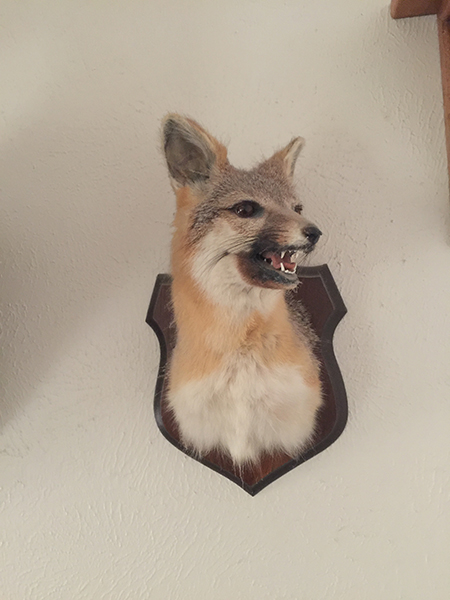
GARY ROBERSON, NOTED PREDATOR HUNTER and call maker, says red foxes sniff the wind more for scents than grays, which come to calls more aggressively with no regard for scent. He says reds are smarter and harder to call. His new book, “Eyes Front” discusses his 60 years of varmint hunting. Google it. A friend provided this picture of red fox he had shot. (Photo by Donnie Scamardo)
I had never seen a fox until one evening as I drove back to college. It had gotten dark. I rounded a bend, somewhere between Conroe and Navasota on Hwy. 105 and saw what looked like a little fox jumping up to catch a bug.
I turned around and went back. Pulling off the road and shining my headlights on the field, there was the fox, still chasing insects. They seemed to be grasshoppers. It went on for several minutes. I laughed at its antics and continued my pursuit of higher education.
After college, I joined the workforce. And fell in among guys who hunted a lot and played organized softball the rest of the time. A couple of guys asked me to join them on a fox hunt. So, I did.
I arranged permission for us to hunt a ranch near Dripping Springs. My buddies had a light, a heavy car battery it took both them to carry, a spotlight, and mouth-blown callers. I packed a borrowed Remington .222 rifle. It was a great adventure into the Hill Country darkness.
Early on, my friend, Carl, broke our silent vigil with his raucous mouth-blown fox call. Suddenly shattering a quiet and chilly night, the hair stood up on the back of my neck. Then silence returned. As Carl called again, I heard a cross between a cough and a small dog’s bark somewhere in the brush – perhaps 50-yards away. Carl softly whispered , “That gentleman is a fox!”
We never saw it. But as you can tell, that evening has stayed close in my memory for half a century. It was probably a gray fox. They’re plentiful. Texas also has red foxes, kit foxes, and swift foxes. I’ve never seen a swift fox. Maybe they’re too fast to see. They are only found in western third of Texas.
Grays are gray; reds are larger and reddish-orange. Kits resemble small grays with big ears and are now considered the same critter as swifts, having pale yellow fur with brownish ears. Grays will fool ya, too. They’ve got a little rusty look along their lower ribs and around their mouths and have a black stripe down the top of their bushy, gray tail. Some mistake them for red foxes.
I received a call about an interesting lady who thought she had seen a strange animal. I appreciate calls about wildlife and my column and learn from each one. This lady said she had seen red foxes around Falls City. Then she moved to Pleasanton and saw something like a fox, but it was gray. She wondered if the different soil made a difference.
Keen observation. Karnes County may have more reddish soil; Atascosa maybe more gray. But that’s not the answer.
The “Mammals of Texas” shows that both counties lack either fox but are near other counties having red and gray populations. That makes me believe either reds or grays could cross the line into either county.
They move freely.
JJ





